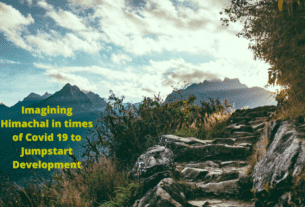By Rajeev Khanna In his death, environmentalist GD Aggarwal has left a strong message for the hill state of Himachal Pradesh. Like Aggarwal’s ‘Karambhoomi’ of Uttarakhand, the neighbouring Himachal is also facing similar issues pertaining to the treatment being meted out to the rivers. Eighty seven year old Aggarwal died on Thursday after fasting for 111 days for ensuring ‘Aviral’ or free flow of Ganga and for keeping the river clean. This former professor at Indian Institute of Technology Kanpur had carried out a series of agitations over the last one decade which involved at least five fasts to persuade the government to make the Ganga free of pollution and ensure its free flow. It is no secret that the rivers of Himachal are also ailing. They are reeling under pollution and the unhindered load that the numerous hydro power projects have placed on them and the population that earns its livelihood in their basins and along their banks. These rivers be it Beas, Sutlej, Ravi, Parvati, Chandrabhaga, Giri and many others are no less sacred than the Ganga for whom Aggarwal sacrificed his life. They carry sewage, industrial effluents and are bearing the brunt of the climate change that has been caused by the so called developmental policies that are serving the greed of a few at the cost of the need of the majority. As environment activist Manshi Asher of Himdhara Environment Research and Action Collective points out, “Aggarwal was not fighting only for a clean Ganga. His fight was also for the free flowing Ganga. In Himachal the entire thrust is on the hydro power projects. The authorities are not ready to give up this thought process and understand how detrimental t is. There is no acceptance and development is looked at from only this side and there is only a wishful thinking.” She pointed out that Himachal has had its own set of visionaries like the first Chief Minister Dr YS Parmar who had a different and people centric approach to things. “At present there is no engagement on the part of the authorities to in terms of dialogue with civil society groups, activists, communities and local organizations. This engagement is required for bringing about a paradigm shift in the thought process. The approach has to be multi disciplinary and all the major stakeholders have to be taken into confidence,” she underlined. Her views were further echoed by Indresh Maikhuri, an activist and CPI (ML) leader in Uttarakhand who has been associated with various movements to save the rivers in the neighbouring state that has a topography and demography very similar to Himachal. He believes that the issues of rivers and the people living along them are similar not only in these two states but other Himalayan states as well. “The struggle of the people exists in an atmosphere where the government is insensitive. The demise of Aggarwal who died after fasting for 111 days is the failure of the state that is duty bound to not let people die. The selling of the rivers and their waters does not augur well for the future generations. When water is allowed to become the property of private corporations it is the people and communities living along the river banks that take the first and the worst hit. It is against this plunder of the natural resource of water that the people will have to come together. A lone GD Aggarwal cannot do anything,’ he said. It needs to be understood that the nature has provided enough for the human need but not greed. The political and bureaucratic class will have to show some foresight and come forward to take the people along when it comes to formulating developmental policies in the tiny state of Himachal Pradesh. The writer can be contacted at rajeevsolan@gmail.com]]>




Superfine efforts